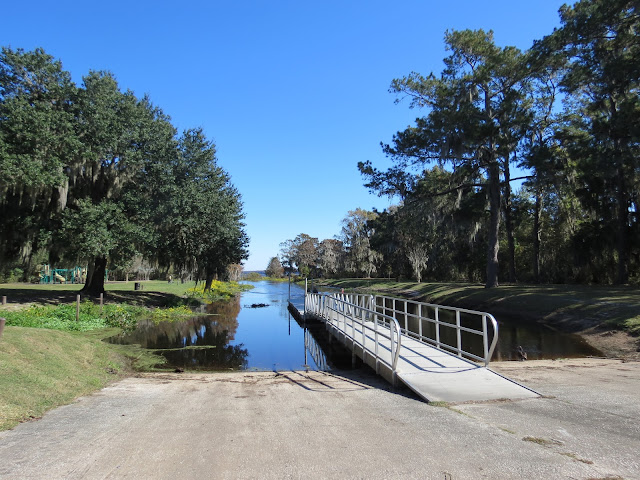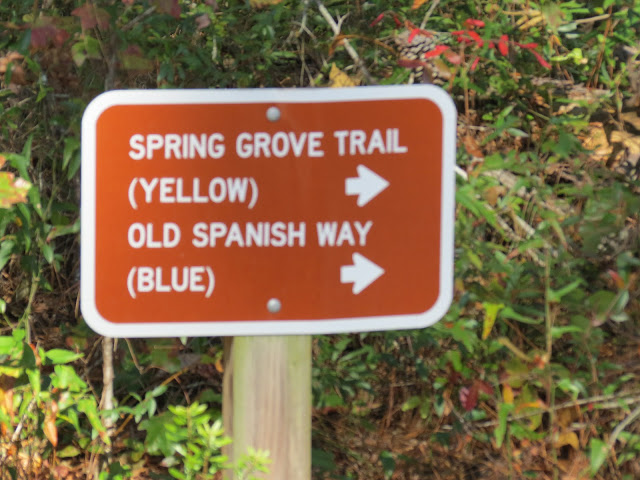Spent the day today with my RV forum friend, Nan, visiting some nearby State Parks and other scenic sites. Our first stop was at Dudley Farm Historic State Park in Newberry. We were the only visitors early this Thanksgiving morning. We decided we might have to come back for their Cane day festivities.
The Dudley family began developing this farm in 1881.
The homestead consists of 18 buildings, including the family farmhouse with original furnishings. The yard was well landscaped with no grass to tend.
The sitting room sported an upright piano, not seen in this photo. The Dudleys raised a large family here...12 children, I think.
Sugar cane fields can be seen. The Dudleys squeezed and produced their own cane syrup. They will be demonstrating that process here on December 1st.
The wash house has examples of wash day activities through the years. Under the roof is a "modern" electric wringer washer.This building served as a pantry for storing canned goods.
I chatted with these fine turkeys and assured them they were safe for this Thanksgiving Day.
The kitchen was in a building separate from the house, a common practice for fire safety.
Located on the Old Gainesville Road, the Dudley farm operated a General Store.
And inside the store, a local Post Office.
The Dudley's used pine trees on their property to build all of their buildings and fences. There were several fenced off areas for various livestock.
Nan is checking out the sweet potato storage cellar.
THe Old Gainesville Road looks pretty much as it did in the days of horse and buggy. Today's highway was built a little farther south.
Beautiful roses on the property.
Pileated woodpeckers and other birds could be seen or heard.
After our self-guided tour of the farm, we decided to go to another nearby State Park, Devil's Millhopper. The road to it is a scenic byway. There are a lot of "green" areas in and around Gainesville, I have discovered.
How it got it's descriptive name.
The developed park has a boardwalk with steps leading to the bottom of the sinkhole. Of course, going down is the easy part...
On the way down we can observe the layers of sediment that reveal a cut-away view of Florida's geological past. The shells and bones of marine animals in the lower layers tell of a time when this area was covered by the sea.
Quite old...
Let's go down, we can do it.
Nan grew up in Gainesville. She is recalling a time when there were no steps or development. She and here friends played here, sliding down the slippery clay slopes to the bottom.
There are 232 steps down. Seemed like more than that going back up.
The sight and sound of water flowing down the slopes of the sink made this an enjoyable playground back in Nan's childhood days. The water begins as rain seeping through the limestone layers spilling out to form 12 springs around the sinkhole.
The water cascades to the bottom,
Where it flows into a natural drain into the underlying aquifer, and eventually makes its way to the Gulf of Mexico.
The spring water cools the sink in summer and warms it in winter, allowing for much lush vegetation and unique life to exist here. This needle palm is commonly found in wet shady places in South Florida, but is rarely found in Northern Florida except in ravines and sinks like this one that seldom see freezing temperatures.
Water flowing in the bottom.
Springs seeping from the side to form waterfalls.
Nan and her friends found many fossil shark teeth while digging in the pools of water. The sink is protected against such activity today, to preserve it and prevent erosion along the sides.
On the way to our Thanksgiving dinner we drove by Newnan's Lake to search out a place to launch the kayaks some day soon. Palm Point Park was pretty, but kayak launching would be difficult.
Just up the road is this park with a nice paved boat launch and nearby grassy area for inflating the kayaks.
The canal leads out to Newnan's Lake.
Plenty of birdlife to enjoy.
Continuing along the country roads we stopped to check out this Wildlife Management Area.
I see a future hike from here.
This sign caused us pause, but I found out the permit is not required for hiking....only hunting or fishing.
One more brief stop in Evinston to photograph the oldest working Post Office in Florida. They sell fresh vegetables here too...
Grown in their garden out the back door....now that is fresh! I'll have to come back on a day the Post Office is open, so I can see the inside. (And buy some fresh vegetables.)
We ended the day with a yummy Thanksgiving Day buffet at the Orange Lake VFW.

























































